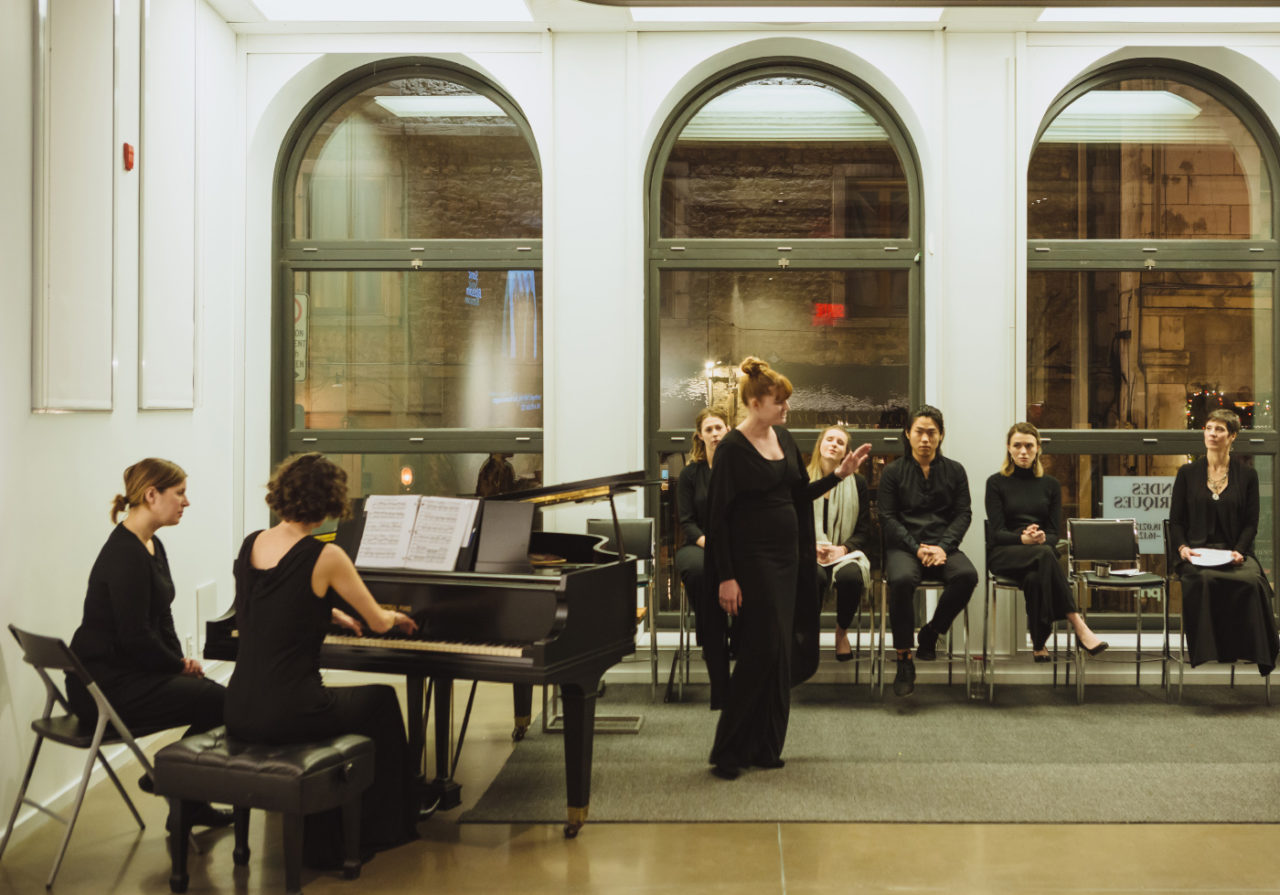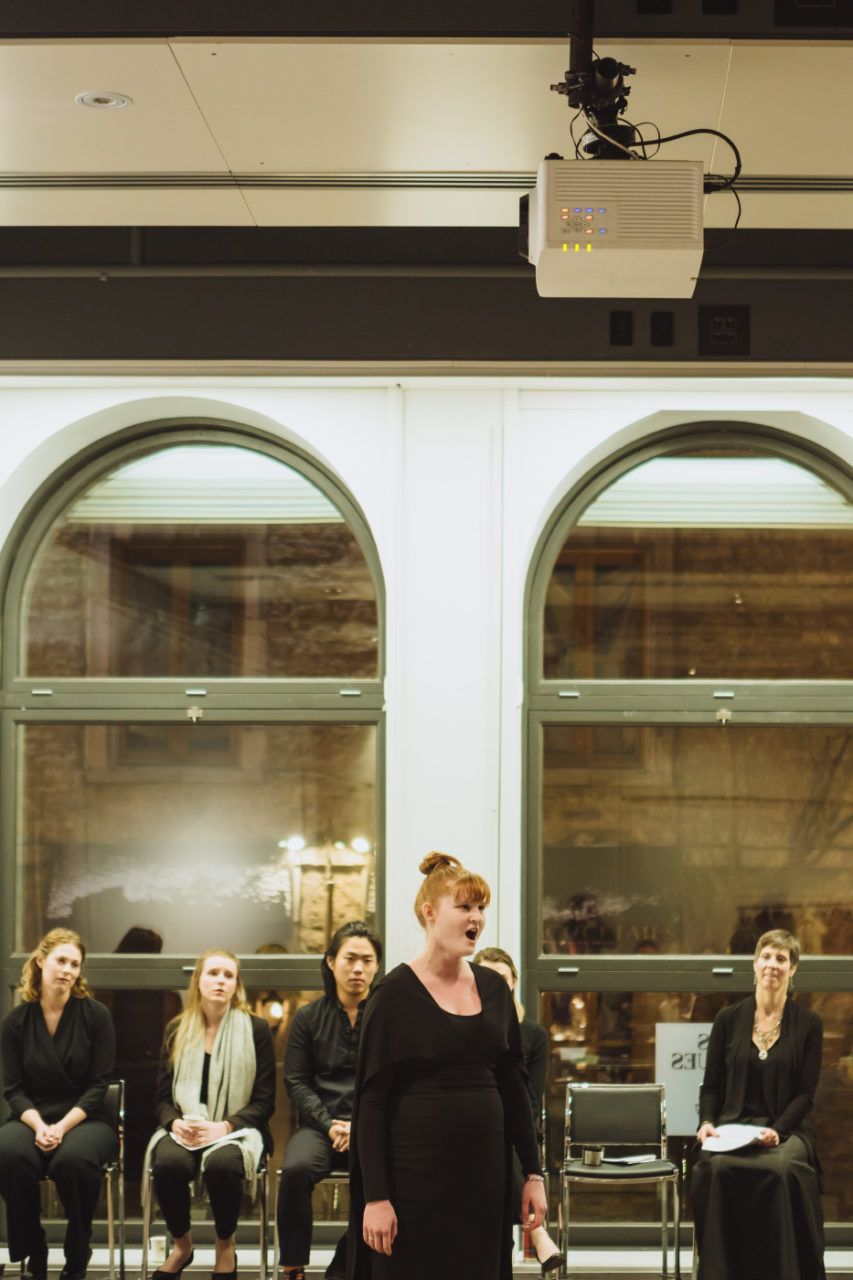Sonic Blossom, created in 2013 after the artist’s mother underwent an invasive surgery, explores the connection between two beings, and how that relationship can be altered by the offering of a transformational gift. The ephemeral quality of the work creates an opportunity for the viewers and the receiver to acknowledge the beauty in something so short and sweet, and serves as a reminder to live life with that same perspective.
My name is Anna Sadofsky, and I have been working at DHC/ART since August 2016. For the exhibition L'OFFRE, I act as a caretaker for the singers in Sonic Blossom by Lee Mingwei. My participation in this piece allows for the singer to maintain a position of a demigod, acting as somewhat of a buffer between the singer and the recipient. I have been fortunate enough to witness and experience the power of the performance firsthand, and have engaged in conversations with all of the singers to reflect on this magical piece. Each singer has answered a selection of questions in an interview format about the show and their encounters, while explaining why this piece has become so special and will leave a lasting impression in their lives.

As performing is a continuous aspect of your life outside of the position of demigod in the Sonic Blossom piece, the process of preparing for a role is something of familiarity. What does your routine prior to each Sonic Blossom performance consist of, and how does it vary from roles you’ve explored in past productions?
Samantha Borgal: First, I show up on time, then I get changed out of my winter clothes (boots, jacket, etc.) I wear the same black dress every time I perform, it helps with the routine of it all. I leave this costume at DHC/ART in the greenroom. Then I stretch, physically and vocally, by doing voice warm-ups, starting slowly and performing exercises such as humming, sighing at different notes, vowels, just feeling the resonance in my mouth. Then you, or the caretaker, performs a soundcheck with the speakers and the iPod to verify the level of the music. It’s a way for me to refresh myself before each performance, familiarize myself with the songs again, continuing to move around and testing out the voice and the role. I always have tea; earl grey. I used to never have milk or cream because it’s bad before you sing, but I don’t care as much anymore. Preparing for this role is unique in the sense that I’m offering a gift. How do we use this as a gift, and make it different than singing to sing? It’s more intimate. I’d say my role continues to take shape as I see the visitor I will be singing to, I’d treat an elder differently than a child, or a traveller versus a local.
The Transformation Cloak worn for each presentation introduces a variety of inquiries by the visitors, both on its visible beauty and its importance to the overall piece. How has the costume come to play a part in your characterization of this role? At this point in the show, do you feel presenting the gift sans-robe would affect your performance?
SB: Wearing it is integral to the experience, both of the receiver and myself, you need something that draws attention to you that lets people know that you're not a normal character or a fellow visitor. We're doing something special, it’s necessary to look special too. The first time I tried it on I felt the heaviness, the physical weight of the gown, I thought, “how am I going to sing in this?” Once I got used to singing in it, [the weight] felt so good and I felt grounded by the cloak. It’s food for my posture, and the weight is almost like a hug it’s so reassuring. The fact that it’s been worn by singers prior to its time at DHC/ART reminds me that it’s bigger than just me, and that I’m part of a larger exhibit that allows me to meet humans and be creative. It’s comforting, and being made of ancient Japanese Obi and the patches that preserve its loved state, all of these things make [the cloak] integral, without it it wouldn’t be the same performance. You could change parts of the garment, but you can’t change the magesticity of it, it’s the backbone.
Many visitors are unaware of the emotionally charged backstory that spurred the creation of this piece prior to receiving the gift. Do you find the responses of the visitors change in any way once they’re informed of the origin of the work?
SB: You know, sometimes it comes up, and other times it doesn't. The idea of caring for someone else and connecting with music, healing with music, it speaks for itself in the way the show has been organized. The essence of its birth is always present in the piece, the explaining of the backstory isn't necessary in experiencing the intimacy of the exchange. The music speaks for itself. It doesn't take away or add anything, the experience is beyond the story.
You’ve encountered visitors who have backgrounds in music, singing, or a familiarity with the German language. How does the exchange differ, if at all, when the receiver is familiar with the aforementioned attributes, in comparison to visitors with no experience in those fields?
SB: Usually the people who are familiar with those fields let me know, and sometimes people become tearful due to their pre-existing relationship with them. People who are or know German are often touched to hear their language sung back to them, and they’re flattered even though the song may not have been meant to be sung by a non-German person.
The spontaneity of the offering often catches visitors off guard, and frequently leads to a beautiful and emotional exchange, somewhat led by the innocence of the receiver. Due to the uninhibited reaction of the receiver, you’ve surely encountered a variety of responses once the piece is finished. From facial expressions to verbal exchanges, are there any moments or comments that have aided in shaping this experience that you’d like to touch on?
SB: Definitely. Today, for example, a little girl aged three or four was with her parents. Before I approached the family, I tried to assess her. She wasn’t running or hiding behind her parents, so I offered her the gift. You have to change how the invitation is said when speaking to children, trying to reduce intimidation. I chose to sing Du bist die Ruh, it reminds me of a lullaby; soothing and peaceful. It’s a song about dedication, it sounds sweet and I felt more appropriate for children out of the other songs because of its nature. During the performance, the little girl was moving around, she seemed a little shy but I made sure to share my gaze with them equally, and used dramatic expressions to maintain interest from the child. The little girl visibly relaxed, and almost sunk into her mom before reaching for her dad’s hand. After the performance, she told me that she liked to sing herself. A little bit later, I sang to another couple while the family was still on the fourth floor [where the performance takes place], and the little girl actually ran and sat in front of the couple for the duration of the performance, it was such a sweet moment.
Working in a therapeutic setting, the use of music or song to evoke emotion and generate a comfortable environment is something you’ve grown accustomed to. Although infrequent, some visitors respond somewhat awkwardly to the intimate nature of the gift. I’m curious as to how do you feel in such situations, as the true powers of music and nonverbal communication are notions you recognize outside of the Sonic Blossom setting?
SB: It’s not surprising when people react awkwardly, it’s not something they experience often. People also misunderstand the offering or what it entails, and there are plenty of awkward moments. The elevator ride is uncomfortable too, but the cloak and the characterization allows for this awkward presence, it adds to the anticipation of this somewhat awkward encounter and it allows it to exist. People are often surprised by their own reactions during the performance, they’re in awe of the human voice. Sometimes people's eyes travel, but it’s important to let people feel awkward and feel that tension, and I respond to their eye contact by letting my eyes wander as well. I try to hold the space and continue to sing, and I allow them to choose the level of interaction before, during and after the experience. I am the medium facilitating the experience, it’s about being there for the music and the music affecting them, and as long as I’m being authentic with my singing the rest will take care of itself.

Anna Sadofsky
DHC/ART
Photos: Marc-Olivier Bécotte